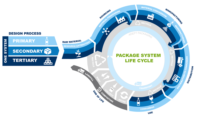Materials Technology: Plastic Packaging
Addressing the plastic recycling issue
What innovators can do to help fix the plastics system.






The linear economy, of which plastics packaging value chain is an iconic example, is ripe for disruption. Without a doubt, plastics bring many benefits, and society as we know it would not be able to work without them. But it is becoming increasingly evident that the current, linear plastics system is broken (Figure 1). Globally, only 14% of plastics packaging is collected for recycling, with even less actually making it back into applications. This means that money is being left on the table every day – a loss of $80-$120 billion of material value per year to the global economy.
It has resulted in a heavy environmental toll that is increasing exponentially. A staggering one-third of all plastics packaging leaks into the environment – a rate so high that by 2050 there could be, by weight, more plastics than fish in the ocean. The rest is either landfilled or incinerated with adverse health and environmental impacts. The total negative externalities from the linear plastics system are hard to quantify, but a conservative estimate by UN Environment valued them at$40 billion a year – more than the industry’s entire profit pool.
The circular economy offers a framework to rethink this broken system and provides an attractive vision for a new plastics economy. The vision of the New Plastics Economy initiative is to create an effective economy for used plastics, drastically reduce the negative effects of the current plastics system, and gradually find alternatives to fossil fuels to make virgin plastics (Figure 2).
Following the outlining of these ambitions in the report “Rethinking the future of plastics,” the New Plastics Economy initiative was set up as a three-year collaborative project with a broad group of leading companies, philanthropists, policymakers and NGOs. Radical innovation is a crucial enabler to accelerate the momentum toward the vision of this initiative, and consequently one of its goals is to mobilize large-scale ‘innovation moonshots’.
We recently published the report “Catalysing Action,” in which we outlined three widely endorsed strategies to start the transition from a linear to a circular plastics economy (Figure 3). The report found, encouragingly, that recycling and reuse can be economically attractive for 70% of all plastics using current or nascent technologies.
However, it also concluded that 30% of plastics packaging by weight (or >50% of all items) is destined by design to become waste. These items will never be recycled unless radically redesigned or re-invented. Such items include small-format items like caps, straws, medical packaging and tear-offs, and multi-layer, multi-material laminates, as used in crisp bags, pouches and sachets.
Items like these play a big role in getting important products to people and in global supply chains, and a multitude of innovative solutions have gone into rendering them lighter, cheaper and more high-performing. The catch is that these developments have been pursued in a linear plastics economy, with no system-wide framework to guide innovation toward the goal of creating a plastic system that works overall. As a consequence, small and multi-material items are technically difficult and very costly to recycle compared to the value of the material recovered, meaning that reuse and recycling rates are, and are expected to remain, vanishingly low.
With no economically viable route to reuse or recycle, small-format, complex or multi-material items are the most prone to end up in waterways and the ocean. It is not enough to treat the symptoms: People familiar with the data unanimously say that beach clean-ups and other efforts to remove plastics from the ocean, while helpful, are only a bandage as long as we fail to prevent plastics ending up where they don’t belong.
If we want to free our oceans from plastics, we have to fundamentally rethink the way we make, use and re-use plastic items so that they don’t become waste in the first place. The New Plastics Economy can be the system-wide framework that guides innovation in the right direction. But we also need innovative new solutions, including system-compatible materials and designs.
Taking on this challenge is a completely new ball game for innovators in the plastics industry. It requires incorporating a wider and more complex set of parameters in design and material choice, developing a deep understanding for both user needs and waste management infrastructure, and potentially revisiting the underlying business model. But if the industry is not used to doing that, how are we to successfully address the problem of the 30%?
For instance, how about putting out a global call to action, with a big incentive attached? On May 18, 2017, we launched the $2 million New Plastics Economy Innovation Prize, which aims to stimulate innovation to find systemic and long-term solutions that might otherwise not be pursued. Because 30% of plastic packaging poses such a formidable and growing global challenge, we are calling on innovators to find alternative, recyclable materials, and to re-imagine the design of plastic packaging to find innovative solutions that collectively would help create a plastics system that works.
It is of course a daunting task that will draw on everyone’s creativity. As readers of this magazine are better positioned than most to understand, trying to figure out how to put in place all the systemic and technological changes we need to accomplish, it is a still a dizzying exercise. However, we can’t build the economy we want if we can’t imagine it. The New Plastics Economy initiative sets out a vision of what this economy could look like for plastics, and the Innovation Prize invites scientists, entrepreneurs, inventors and designers to help us reimagine the technologies and design solutions that will get us there.
Submissions to the Circular Materials Challenge, comprising one half of the New Plastics Economy Innovation Prize, close on October 20, 2017. To learn more and to participate, visit: ninesights.ninesigma.com/web/circular-materials.
The Ellen MacArthur Foundation was created in 2010 to accelerate the transition to a circular economy. The Foundation works across five areas: insight and analysis, business and government, education and training, systemic initiatives, and communication. With its Knowledge Partners (Arup, IDEO, McKinsey & Co., and SYSTEMIQ), and supported by Core Philanthropic Funder (SUN), the Foundation works to quantify the economic opportunity of a circular model and to develop approaches for capturing its value. The Foundation collaborates with its Global Partners (Danone, Google, H&M, Intesa Sanpaolo, NIKE Inc., Philips, Renault, Unilever), and its CE100 network (businesses, universities, emerging innovators, governments, cities and affiliate organisations), to build capacity, explore collaboration opportunities and to develop circular business initiatives. By establishing platforms such as the New Plastics Economy initiative, the Foundation works to transform key material flows, applying a global, cross-sectoral, cross value chain approach that aims to effect systems change.
For more information, please visit newplasticseconomy.org/@newplasticsecon
Looking for a reprint of this article?
From high-res PDFs to custom plaques, order your copy today!










